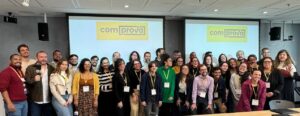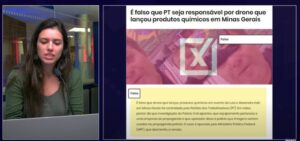On April 14, the mayor of Guarulhos, a city of 1.2 million inhabitants in the São Paulo Metropolitan Region, published a video on Instagram generated through artificial intelligence (AI) of a crowd chanting “Fora PT” (Workers Party, Leave). A court ordered the removal of the video from the social network and fined the mayor 5,000 reais (about US$885).
The episode illustrates the size of the challenge for Brazilian journalists planning to cover municipal elections on Oct. 6. Brazilians go to the polls to elect mayors, deputy mayors, and councilors in 5,565 cities across the country. As in previous elections, online disinformation requires special attention, particularly with the speed at which content is disseminated and the increasing sophistication of information manipulation techniques, such as deepfakes.
Deepfakes are fake videos, audio, and images that appear authentic, like the one released by the mayor of Guarulhos. In the electoral context, they can be videos in which a candidate appears to say or do something that they never actually did, or in which they make controversial or offensive statements, or which place them in compromising situations or that distort reality to deceive voters.
The Superior Electoral Court (TSE, for its acronym in Portuguese), the judicial body responsible for the electoral process, banned parties and candidates from using so-called deepfakes. Electoral legislation also determines that content developed using AI tools should be properly labeled as such. But in practice, regulation alone does not prevent the creation and sharing of this content.
In this context, Brazilian newsrooms are adopting a series of measures to improve reporting tools and avoid errors in election coverage. The most ambitious and comprehensive initiative is led by Projeto Comprova, a consortium led by the Brazilian Association of Investigative Journalism (Abraji). It’s made up of 42 media outlets that have set up a task force of 111 journalists to check false news and deepfakes during the electoral campaign.

A group of journalists during Comprova training in São Paulo. The consortium looks for false content that could be reused in the 2024 campaign. (Credit: Marco Túlio Pires)
Some of the strategies used by the consortium to prepare participating journalists for coverage include explanatory videos, texts on the operational functioning of new AI tools, and anticipation of false content that circulated in other elections and that could be used again.
“It is important for journalists to consume information about how AI is used, and to see how it works and how difficult it is to detect. The most delicate point is the generation of content from scratch, which requires greater concentration to be identified,” José Antonio Lima, assistant editor of Comprova, told LatAm Journalism Review (LJR).
“Another sad aspect is that those who misinform try and succeed in making the debate poorer. This is part of the objectives to undermine the work of mediators of public debate, undermine people's beliefs, and make absurdities become acceptable,” he added.
Checking information shared on social networks and verifying rumors are already tasks incorporated into the daily routines of countless newsrooms. In election years, work has grown as candidates and supporters strive to disseminate false news as a campaign strategy.
Agência Lupa, a pioneering media outlet in the fight against disinformation in Brazil, is following the emergence of deepfakes in the electoral context with concern, but also with caution. This is because there is still little data on how common this content is and its impact on the electoral process.
“The incidence has increased, yes, but very slowly. We noticed that in the first months of this year, we did more checks on this than last year. But it doesn't seem to me that the data is consistent to the point where we can say that this will or won't be the big problem of this election,” Natalia Leal, CEO of Agência Lupa, told LJR.
“Audio is our biggest point of concern, because for images, both videos and photos, we already have some very developed support technology for identification. In the case of audio, it is practically forensic work, which I consider to be a little beyond what we, as journalists and fact-checkers, have the skills and tools to deal with at the moment,” she added.
Too many campaigns for a few fact-checkers
Municipal elections pose an additional challenge. In a presidential contest, the entire country is mobilized in a single campaign. Coverage is also more focused during state elections. At the municipal level, there are more than 5,000 different cities, and tens of thousands of candidates.
Journalist Luiza Alcântara e Silva, from Folha de S.Paulo, has been dedicated to investigating and checking information for four years. She said that, when covering politics, professionals have always lived with lies and inaccuracies created by politicians, but the industrial scale of disinformation contributed to deconstructing the image of journalism outlets.
“The coverage of municipal elections worries me because there’s a risk they go unnoticed by media because they are more localized. While the initial strategy has focused primarily on large urban centers, our plan is to take a more national approach, taking all cities into account. To this end, we are carrying out a detailed survey of candidates and planning effective monitoring,” Silva told LJR.
It is impossible, however, to check all disinformation out there, especially given the increase in the volume of this content during election periods.
At BandNews, a national news-only radio network, the criteria for investigating include the number of shares and listener interest. These factors help to filter what is being discussed and prioritize what is most relevant. The broadcaster's participation in Comprova contributes to expanding the offering of fact-checks to the public.

Bruna Barone, from BandNews, during a fact-check posted on social media. She highlights the help of listeners in identifying content that can be verified. (Credit: Personal archive)
“Our focus has been to intensify attention on everything related to the elections. The radio uses the material produced by Comprova a lot, selecting relevant subjects and distributing our verifications a lot,” Bruna Barone, journalist and regional coordinator of BandNews, in São Paulo, told LJR.
Audience literacy
If there is good news, it is that, as the phenomenon of fake electoral news on social media ceases to be new, the audience is theoretically increasingly attentive and less likely to be easily fooled. With this, they become an ally of journalists covering electoral campaigns. In Comprova fact-checks, 90% of the content is sent by readers.
“Combating disinformation is comparable to a competition between technology and counter-technology, similar to doping and anti-doping in sports. Despite efforts, texts written on WhatsApp and memes continue to spread. Although there is more sophisticated content that still deceives, media literacy is a crucial point in improving readers' ability to identify and question false information,” Lima said.
For Sérgio Lüdtke, editor-in-chief of Projeto Comprova, coordinator of Atlas da Notícia, and president of Projor, the Achilles heel of combating disinformation is monitoring. The number of platforms has grown while others are more closed. X (formerly known as Twitter), for example, has been charging for access to its API since February 2023. Meta will discontinue Crowdtangle, a Facebook and Instagram monitoring tool, in August.
“What we are noticing is that they are closing the monitoring doors. The LGPD (General Data Protection Law, Brazilian legislation that regulates the internet) also closes doors despite being important. What I see for professional journalism is that we need to expand our capacity and our eyes on monitoring,” Lüdtke told LJR. “Therefore, we need audience support to detect content early, before content goes viral. We need the public to understand that verification takes time and that there is a reporting channel for suspicious content.”